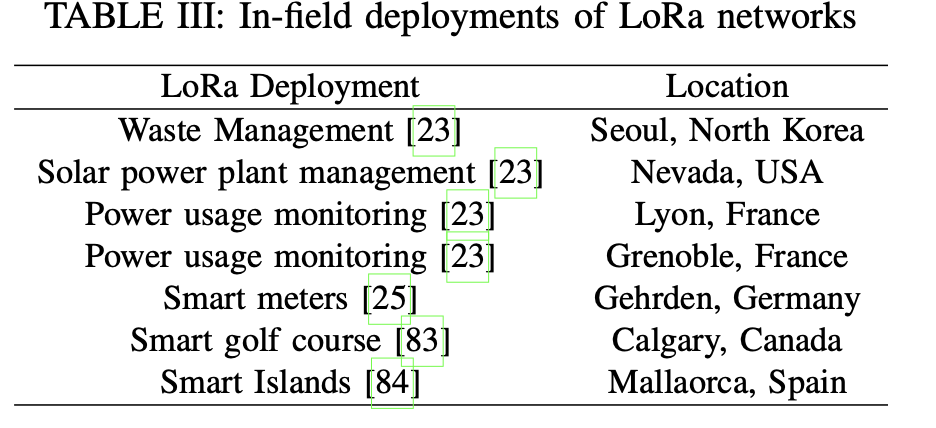Literature Review on LoRaWAN
Notes I took when I read a bunch of LoRa related papers…
All papers are classified into four categories based on what aspect they focus on:
- Survey paper
- Evaluation
- Method
- Applications
Survey paper
-
A Survey on LoRa Networking: Research Problems, Current Solutions and Open Issues

- Existing deployments of LoRa networks
- Research problems:
- Energy consumption
- Harvest ambient energy
- Use backscatter signals for transmission
- Detect and decode weak signals
- avoid retransmission of weak signals
- Communication range
- LoRa backscatter
- Charm (CMU)
- Multiple access
- Link coordination
- RS-LoRa
- S-MAC
- Channel Activity Detection (CAD) and Ideal-CSMA
- Joint retransmission scheme with compression and channel coding
- FREE: Fine-grained scheduling
- Resource allocation (transmission quality)
- Fair adaptive data rate
- Link coordination
- Error Correction
- Security
- Energy consumption
-
LoRa - A Survey of Recent Research Trends
Until 2018:
- Analysis/survey/factual discussion – 7 papers
- Performance/technical evaluation – 29 papers
- Real deployment/experimental/prototype implementation – 37 papers
- Simulation/modeling/networking stack/software – 8 papers
- Applications – 20 papers
-
A survey on LPWA technology: LoRa and NB-IoT
LPWAN application scenarios are categorized and some important parameters to be considered for each specific scenario are studied. Research challenges and recent technical advancements of each technology are not discussed in detail
Evaluation
-
Accuracy Assessment and Cross-Validation of LPWAN Propagation Models in Urban Scenarios
- Propagation models for urban environments and cross-validation
- Models considered: 3GPP, SUI, Ericsson Urban, Hata Urban, COST 231
- LPWAN tech: NB-IoT, LoRaWAN, Sigfox
- Conclusion:
- All of the models need to be fine-tuned to match the propagation specifics
- Tuned Ericsson Urban best for LoRaWAN and NB-IoT
-
Adaptive Configuration of LoRa Networks for Dense IoT Deployments
- Proposed LoRa simulation framework – FLoRa
- Show ADR is severely affected by a highly-varying Channel
- Adaptive configuration considered:
- LoRaWAN ADR (MAX)
- LoRaWAN ADR+ (Average)
- Network aware (optimal SF distribution)
- Simulation setup:
- Urban (480m x 480m) vs. sub-urban (9800m x 9800m)
- Ideal channel vs. moderate variability vs. typical variability
- Result:
- ADR results in a reduction of the energy consumption only in the networks with no channel variability
- ADR+, with more conservative parameter setting, performs much better
- There is a need for an algorithm that configures transmission parameters based on the knowledge of the entire network.
-
Do LoRa Low-Power Wide-Area Networks Scale?
- Measurement:
- Measured receiver sensitivity in dBm for different bandwidths and spreading factors (difference is not 3dB between steps)

- d0=40m, PL= 127.41dB, gamma = 2.08, sigma = 3.57
- Measured receiver sensitivity in dBm for different bandwidths and spreading factors (difference is not 3dB between steps)
- Simulation:
- Simplified path loss model
- Collision model:
- Base of ADR
- Simplified path loss model
- Measurement:
Methods
- DyLoRa: Towards Energy Efficient Dynamic LoRa Transmission Control

- Replacement of ADR
- Improve EE by 41.2%
-
Improving Reliability and Scalability of LoRaWANs Through Lightweight Scheduling
- Introduce a new MAC protocol: RS-LoRa (over LoRaWAN)
- Distributed and two-step light-weight scheduling
- Improved energy efficiency
- Additional cost on regularly listening to channels
- Identify two challenges:
- Scalability: nodes far away from the gateway perform badly because of long transmission time and capture effect
- Interference from other co-located network: result in retransmission
- Restrictions on duty cycle
- First step by gateway:
- sends coarse-grained information of allowed TP and SF for each channel as Class B beacons
- Second step by nodes:
- Each end-device selects one parameter combination from the beacon that better suits the node
- Introduce a new MAC protocol: RS-LoRa (over LoRaWAN)
-
LoRa Transmission Parameter Selection
- Parameter evaluation
- Temporal dynamics
- LoRaWAN ADR is not fine-grained enough to choose good configuration settings
- Parameter selection
- Probing algorithm
- Optimizing probing transmissions
- Early termination of probing
- Parameter evaluation
- Power and Spreading Factor Control in Low Power Wide Area Networks
Optimize the packet error rate for users further away; the fairness
- System model:
1. close to gateways (all settings work)
2. no outside interference
3. Only unacknowledged traffic
- Optimal SF distribution
- Unconstrained power control
- Same SF collision
- Different SF collision caused by low signal to interference noise ratio (SINR)
- Not important
- Min max_SF collisionPr(SF)
- Optimal distribution:
- Equal collision probability
- Discrete power control and limited range
- Lower path loss –> lower SF
- Same P_S
- Unconstrained power control
- Proposed Scheme
- Sorting the nodes by distance/estimated path loss
- Split into k groups and each group is assigned to a different channel (limited path loss in one group)
- 50% improvement in PER for edge users
- Optimal SF distribution
Applications
- Design and Implementation of object tracking system based on LoRa
- On the Application of LoRa LPWAN Technology in Sailing Monitoring System
- A long-range low-power wireless sensor network based on U-LoRa technology for tactical troops tracking systems
- A Two-end Traveling Wave Fault Location System for MV Cables Based on LoRa Technology
- Wireless sensors network for landslides prevention
- Poster: Pilot Deployment of Early Warning System for Landslides in Eastern Himalayas
- A Low-power Real-time Air Quality Monitoring System Using LPWAN based on LoRa
